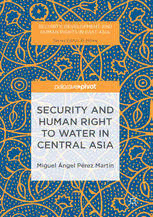
Security and Human Right to Water in Central Asia PDF
Preview Security and Human Right to Water in Central Asia
Security, Development and Human Rights in East Asia Series Editor Brendan M. Howe Graduate School of International Studies Ewha Womans University Seoul Korea (Republic of) Thisseriesfocusesontheindissolublelinksunitingsecurity,development and human rights as the three pillars of the UN, and the foundation of global governance. It takes into account how rising Asia has dramatically impactedthethreepillarsatthenational,internationalandgloballevelsof governance, but redirects attention, in this most Westphalian of regions, tohuman-centeredconsiderations.Projectssubmittedforinclusioninthe seriesshouldthereforeaddressthenexusorintersectionoftwoormoreof the pillars at the level of national or international governance, but with a focus on vulnerable individuals and groups. The series targets postgradu- ate students, lecturers, researchers and practitioners of development stu- dies,internationalrelations,Asianstudies,humanrightsandinternational organizations. More information aboutthisseries at http://www.springer.com/series/14488 MiguelÁngelPérezMartín Security and Human Right to Water in Central Asia MiguelÁngelPérezMartín UniversidadComplutensedeMadrid Madrid,Spain Security,DevelopmentandHumanRightsinEastAsia ISBN978-1-137-54004-1 ISBN978-1-137-54005-8(eBook) DOI10.1057/978-1-137-54005-8 LibraryofCongressControlNumber:2016957408 ©TheEditor(s)(ifapplicable)andTheAuthor(s)2017 This work is subject to copyright. All rights are solely and exclusively licensed by the Publisher,whetherthewholeorpartofthematerialisconcerned,specificallytherightsof translation, reprinting, reuse of illustrations, recitation, broadcasting, reproduction on microfilms or in any other physical way, and transmission or information storage and retrieval,electronicadaptation,computersoftware,orbysimilarordissimilarmethodology nowknownorhereafterdeveloped. Theuseofgeneraldescriptivenames,registerednames,trademarks,servicemarks,etc.inthis publicationdoesnotimply,evenintheabsenceofaspecificstatement,thatsuchnamesare exemptfromtherelevantprotectivelawsandregulationsandthereforefreeforgeneraluse. Thepublisher,theauthorsandtheeditorsaresafetoassumethattheadviceandinformation in this book are believed to be true and accurate at the date of publication. Neither the publishernortheauthorsortheeditorsgiveawarranty,expressorimplied,withrespectto thematerialcontainedhereinorforanyerrorsoromissionsthatmayhavebeenmade.The publisher remains neutral with regard to jurisdictional claims in published maps and institutionalaffiliations. Coverillustration:PatternadaptedfromanIndiancottonprintproducedinthe19thcentury Printedonacid-freepaper ThisPalgravePivotimprintispublishedbySpringerNature TheregisteredcompanyisNatureAmericaInc. Theregisteredcompanyaddressis:1NewYorkPlaza,NewYork,NY10004,U.S.A. Don’tjudgeeachdaybytheharvestyoureapbutbytheseeds thatyouplant RobertLouis Stevenson C ONTENTS 1 Introduction 1 2 AWater History ofCentral Asia 17 3 EnvironmentalSecurity, Water ResourcesandInternational SecurityOrganizations 39 4 EconomicSecurity, WaterResources andInternational SecurityOrganizations(NATO, OSCE,CSTO, SCO) 77 5 PoliticalSecurityWater ResourcesandInternational SecurityOrganizations(NATO, OSCE,CSTO, SCO) inthe Amu Darya 107 6 Conclusions 153 References 167 Index 173 vii L F IST OF IGURES Fig.2.1 CourseoftheAmuDaryariveranditsboundaries 23 Fig.4.1 Technicalandcommerciallossescomparedwithother countries(2010)%ofnetgeneration. 95 ix L T IST OF ABLES Table2.1 Annualwaterflowgeneratedbyshorecountries oftheAmuDaryariver 32 Table2.2 WaterdistributionlimitsintheAmuDaryabasin, followingProtocol566,11March1997 33 Table2.3 PotentialconflictsintheAralbasinandtheirnature 35 Table3.1 SoilsalinizationinCentralAsia 43 Table3.2 Numberofwastedumps,tonsofnuclearwaste andcountrydistribution 48 Table3.3 PollutionrisklevelsofCentralAsianwastedumps 49 Table3.4 StatusofratificationofUNECEenvironmentalinstruments inCentralAsia 68 Table3.5 EUWIcurrentactivities 70 Table4.1 CCA:Selectedeconomicindicators 79 Table4.2 Pricesofoil,cottonandgold 80 Table4.3 Incomepovertytrends(1981–2010,PPP$4.30/day threshold) 81 Table4.4 GinicoefficientsofincomeinequalityfromtheSWIID database 82 Table4.5 ProgresstowardsachievingMDGandWFShungertargets intheCCAsub-region,numberofundernourished (millions)andprevalenceofundernourished(%) 86 Table5.1 Accessibilitytowaterandsanitation 109 Table5.2 Ruralpopulationpercentages 109 Table5.3 Percentageofruralpopulationwithoutaccesstowater 110 Table5.4 Percentageofruralpopulationwithoutsanitation 110 Table5.5 ConflictsrelatedtowaterintheAralSeabasin 114 Table5.6 Degreeofpublicparticipationineachcountryoftheregion 121 xi CHAPTER1 Introduction Abstract This chapter comprises an initial study to introduce the reader toboththeoretical(humansecurity)andmethodological(constructivism) aspects and their relation with the human right to water and the interna- tional security organizations in Central Asia, i.e. the Collective Security Treaty Organization (CSTO), Shanghai Cooperation Organisation (SCO), Organization for Security and Co-operation in Europe (OSCE) and various NATO-sponsored programs. Here, the author explores human security from the perspective of the Canadian School, which sees political decisions as being basic to the allocation of water resources, and considerswaterasawelfareresource.Fromamethodologicalperspective, analysis is based on constructivist school and Thierry Balzacq’s definition of securitization (2011). Accordingly, “securitization” is understood as a discursive strategic process built on a natural resource within the specific framework ofinternational securityorganizations in CentralAsia. Keywords Humansecurity(cid:1)Righttowaterandsanitation(cid:1)Desecuritizing(cid:1) Securitizing(cid:1)Extraordinarypolitics(cid:1)Exceptionalpolitics(cid:1)Empowerment(cid:1) Emancipation Accesstowaterandsanitationarecertainlyapreconditionfortheenjoy- mentoffundamentalhumanrightssuchastherighttolife,health,work, education and protection against torture, as well as being crucial to ©TheAuthor(s)2017 1 M.Á.PérezMartín,SecurityandHumanRighttoWaterinCentral Asia,Security,DevelopmentandHumanRightsinEastAsia, DOI10.1057/978-1-137-54005-8_1
